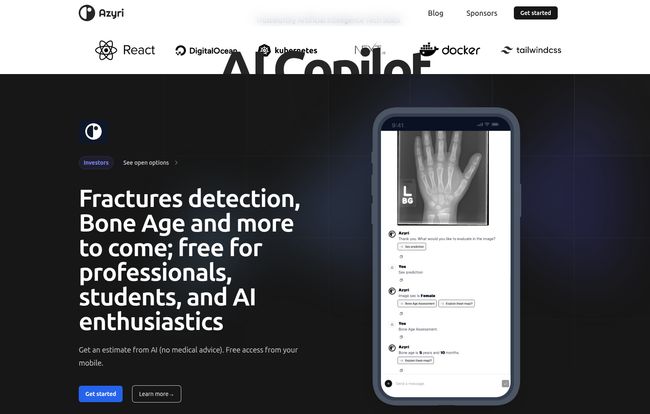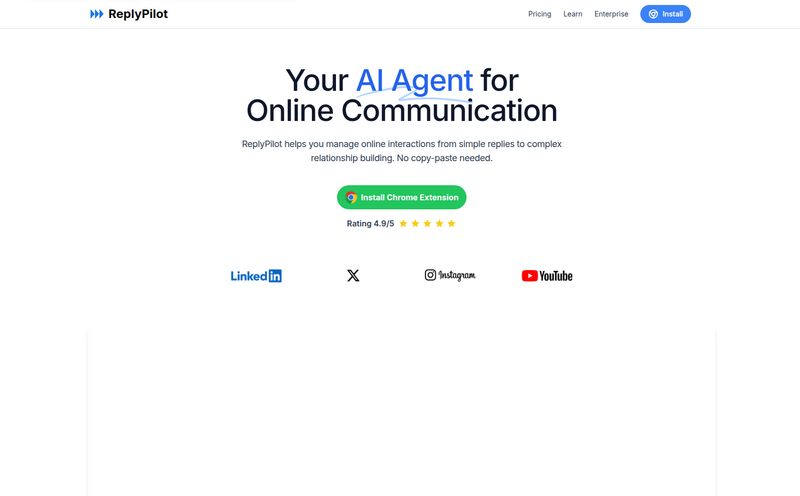I’ve spent countless hours staring at screens. Not just for SEO analytics and keyword trends, but in previous lives and through friends in the medical field. I know the look. That bleary-eyed, caffeine-fueled stare into a monitor, trying to spot a minute detail that could change everything. In the world of radiology, that screen is a light-box or a high-res monitor, and that detail is a hairline fracture, a subtle abnormality, a clue to a patient's health.
The pressure is immense. The volume of images is staggering. And the need for accuracy is, quite literally, a matter of life and death. So when a tool comes along that calls itself an "AI co-pilot for healthcare," my ears perk up. Not just as a tech enthusiast, but as someone who understands the human toll of high-stakes precision work.
That tool is Azyri. And I’ve been digging into what it is, who it's for, and whether it’s just another piece of vaporware or something genuinely useful. Let's get into it.
So, What Exactly Is Azyri?
At its core, Azyri is an AI medical assistant designed to help medical staff with diagnostic X-ray analysis. Think of it less as a self-driving car and more as the most advanced cruise control and lane-assist system you've ever seen. It’s not here to take the wheel from the doctor, but to make the drive smoother, safer, and less fatiguing.
The platform’s stated mission is incredibly ambitious: “Providing the highest diagnosis accuracy to the furthest area on Earth.” That’s… a big goal. It reframes the tool from a simple productivity app to a potential force for global health equity. Suddenly, a small clinic in a remote village could have access to a level of analytical support once reserved for top-tier urban hospitals. A powerful idea.

Visit Azyri
The Standout Features We Need to Talk About
Azyri isn't just a concept; it’s a platform with specific, tangible tools. The homepage highlights a few key areas that are clearly the focus of their development right now.
Fracture Detection and Bone Age Assessment
This seems to be the bread and butter of Azyri. The AI is trained to analyze X-rays to spot fractures. We've all heard stories of subtle breaks, like a scaphoid fracture in the wrist, that are notoriously easy to miss on an initial read. An AI that can flag these potential misses for a second look? That’s not a gimmick; that’s a powerful safety net. It’s like having a tireless junior resident who never needs coffee and has seen millions of X-rays.
But it's not just about breaks. The mention of Bone Age assessment is particularly interesting. For those not in the know, this is a common procedure in pediatrics to assess if a child's skeletal maturity matches their chronological age. It's used to diagnose growth problems and other endocrine issues. It can be a somewhat subjective process, so having an AI provide a data-driven assessment could bring a new level of consistency to the field.
Supercharging Your PACS with Easy API Integration
Okay, this is where the real nerds (like me) get excited. Azyri isn’t a walled garden. It's built to be integrated into existing clinical workflows through an API. For any hospital or clinic, the PACS (Picture Archiving and Communication System) is the heart of their imaging department. It’s where everything is stored and viewed.
The fact that Azyri offers a “Cloud-ready solution and easy API integration” means it’s designed to play nice with these multi-million dollar systems. The website even shows a javascript code snippet, which is more than just marketing—it's a direct message to developers and hospital IT departments: “We speak your language. This is built to be implemented.” This focus on interoperability is a massive green flag in my book.
The AI Chatbot: Your On-Demand Assistant
The platform also includes an AI-powered chatbot. The details on the site are a bit sparse here, but the potential is clear. Imagine being able to quickly query for patient scan data, ask for analytical summaries, or get information related to a specific type of image without clicking through a dozen menus. While it's a feature I'd need to see in action to fully judge, its inclusion shows Azyri is thinking about the user interface and not just the backend analysis.
Who Is This Tool Really For?
Azyri is refreshingly clear about its audience. It’s free for professionals, students, and AI enthusiasts. This is a brilliant move. Let's break that down:
- Medical Professionals: Radiologists, ER physicians, orthopedists, pediatricians. The benefit is clear—a second set of digital eyes to reduce diagnostic errors and improve efficiency.
- Students: Medical students and residents can use this as an incredible learning tool. Imagine being able to upload a practice X-ray and see what the AI flags, then compare it to the official read. It’s like having a virtual tutor.
- AI Enthusiasts: By making it accessible, Azyri is inviting a community of developers and researchers to engage with their platform. This can lead to faster innovation, bug-spotting, and maybe even new applications the original creators never dreamed of.
What's the Catch? Let's Talk Price and Limitations
So, it’s free. How? The site mentions “Sponsors,” which suggests a model where larger organizations or grants fund the platform to support its mission of accessible healthcare. I have to say, that’s a far more appealing model than a “sell your data” approach. For now, the lack of a price tag is a huge advantage, removing the primary barrier to adoption for individuals and smaller institutions.
Of course, no tool is perfect. There are some important guardrails in place. The AI does not provide direct medical advice. This is crucial. It presents data and analysis, but the final diagnostic decision rests firmly with the qualified human profesional. It's a tool for support, not a replacement. Additionally, there are copyright restrictions on the content, which is a standard and necessary legal protection.
The Human and AI Collaboration
The conversation around AI in medicine is so often framed by fear. The fear of replacement, of losing the human touch. I've always felt that's the wrong way to look at it. I see tools like Azyri as a form of collaboration. A human expert’s intuition, experience, and empathy paired with an AI's ability to process massive datasets without fatigue or bias.
Some might argue that relying on AI could dull a doctor's skills. It's a valid concern, but I think the opposite is more likely. By handling the more repetitive and data-heavy parts of the job, AI could free up physicians to focus on what they do best: complex problem-solving, patient communication, and holistic care. We don't say a pilot is less skilled because they use an autopilot system; we say they are better equipped to handle the overall flight and any emergencies that arise.
Frequently Asked Questions about Azyri
Is Azyri a replacement for a radiologist?
Absolutely not. It's designed as a co-pilot or an assistant. It provides analytical support to help qualified medical professionals make more accurate and efficient diagnoses. The final call always belongs to the human expert.
How much does Azyri cost?
Currently, Azyri is offered for free to medical professionals, students, and AI enthusiasts. The platform appears to be supported by sponsors.
Can I integrate Azyri with my hospital's existing software?
Yes. Azyri is built with API integration in mind, specifically to connect with PACS (Picture Archiving and Communication System) software common in hospitals and clinics.
What kind of images can Azyri analyze?
Its main focus is on diagnostic X-rays, specifically for detecting fractures and performing bone age assessments. The platform indicates more features are in development.
Is the Azyri AI giving medical advice?
No. It provides data and highlights areas of interest on an image. It is a diagnostic support tool, not a medical advisor. All diagnoses must be made by a qualified doctor.
Is Azyri safe and reliable?
Like any new technology in healthcare, it should be used as a supplementary tool. Its reliability for improving diagnostic accuracy is its main selling point, but it should be used within a framework of professional oversight and validation.
Final Thoughts: A Glimpse into the Future of Medicine?
So, is Azyri the AI co-pilot we've been waiting for? It's too early to say for sure, but the signs are incredibly promising. It’s tackling a real-world problem with a specific, well-thought-out solution. The focus on API integration shows technical maturity, and the mission-driven, free-access model is both admirable and smart.
It avoids the hubris of claiming to replace doctors and instead embraces the role of a powerful assistant. That, in my experience, is where AI truly shines today. Not as our replacement, but as our partner. Azyri is a project I’ll be watching closely. It feels less like another piece of tech and more like a step toward a smarter, more accessible future for healthcare. And that's something to be excited about.
Reference and Sources
- Azyri Official Website
- The Future of AI in Radiology: A Conversation with Experts - Radiological Society of North America (RSNA)



